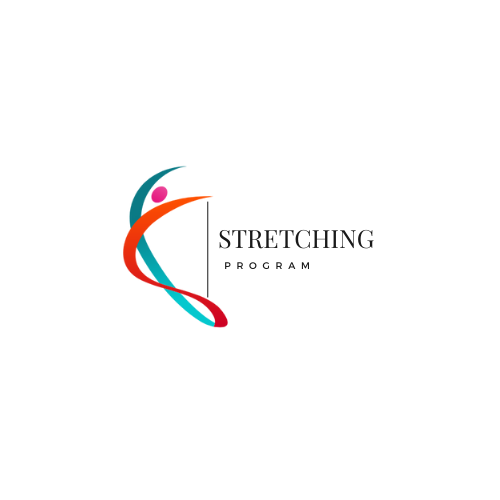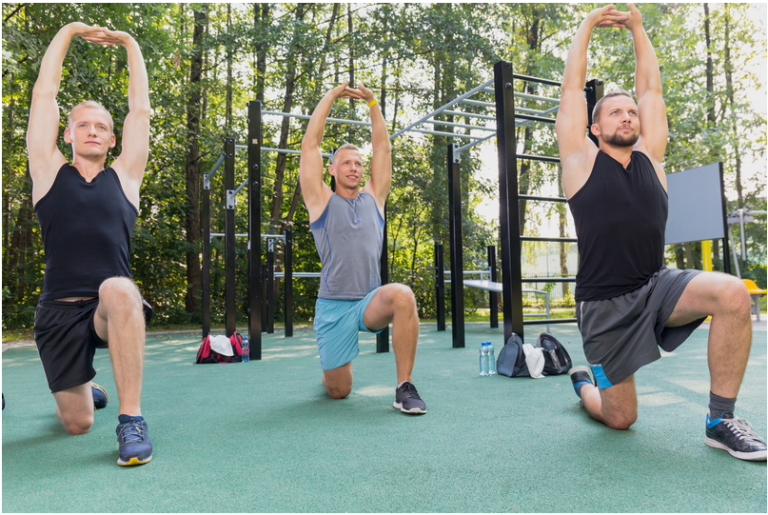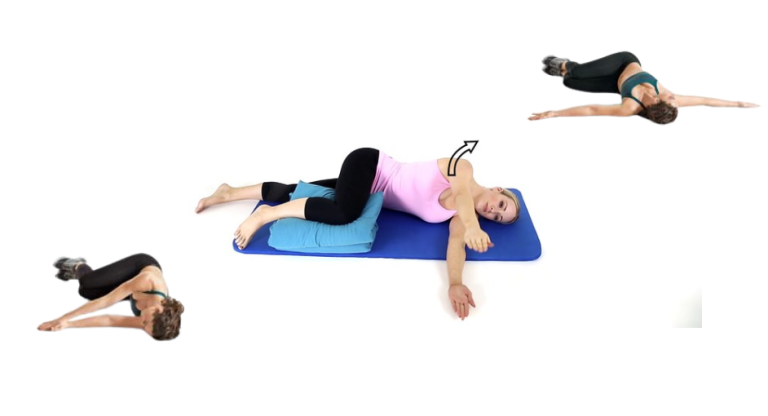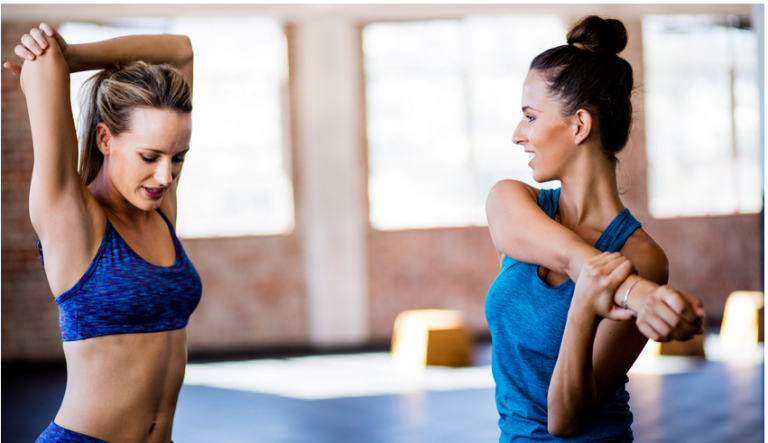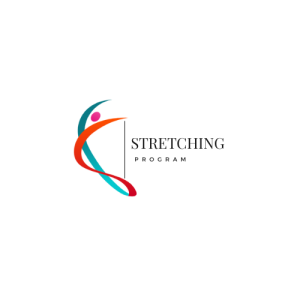
5 Must-Try Lats Stretching Exercises for Flexibility and Strength
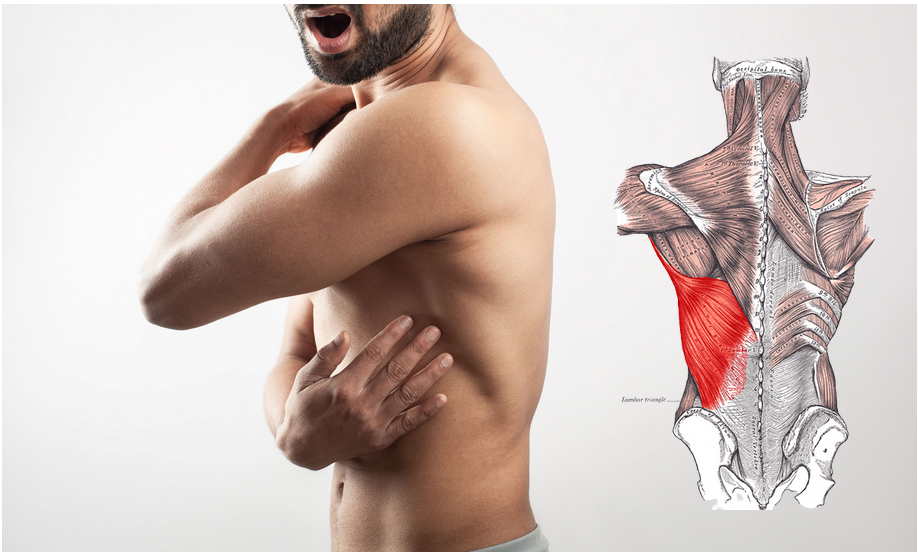
We all know the feeling—after wrapping up that last email for work or stepping off the treadmill, a familiar tightness creeps across our backs. It’s as if our lats remind us of their constant hard work supporting our daily grind (and gym time, too).
This is where the importance of lats stretching exercises comes into play. Incorporating these exercises into our routine can help alleviate that tightness, improve flexibility, reduce discomfort, and ensure our lats get the relief they deserve after a long day or an intense workout.

As seasoned fitness pros with countless hours under our belts, training and cheering on others at the local gym, we’ve become acquainted with what it takes to keep those pesky lat muscles happy and limber.
Did you know your latissimus dorsi muscles are like unsung heroes whenever you power through a swim-stroke, conquer another set of pull-ups, or master your rowing technique? These expansive back buddies have got your back—literally—and can help whisk away some of those aches when treated right.
We’re thrilled to share a collection of expert stretches with you folks that will ease out those knots and open up new frontiers in mobility for you. Picture this: gliding through your day with lats so loose and free, you’d think they had their superhero capes! Excited yet? Follow along as we unfold these stretch secrets together! Let’s get ready to embrace that feel-good vibe from shoulder to hip….
Key Takeaways
- Tight lats can cause discomfort and restrict movement, which stretching can help.
- Stretching the lats increases the range of motion, improves posture, and lowers injury risk.
- Foam rolling complements stretching by releasing muscle tension for better flexibility.
- Specific exercises like hanging lat stretches and bench kneeling stretches are good for the lats.
- It’s best to learn correct techniques for lat stretching to avoid overstretching or injury.
Understanding the Lats Muscle
The lats muscle, also known as the latissimus dorsi, is the largest in the upper body and is responsible for various shoulder joint movements. It plays a crucial role in pulling, rowing, and lifting activities.
Understanding its anatomy and function can help us appreciate the importance of stretching exercises for this muscle group.
Anatomy
So, our lats, or latissimus dorsi muscles, are these big, broad muscles that spread across the lower part of our backs. They’re shaped like wings and help connect our arms to our backbones – pretty cool, right? These muscles work hard when we pull stuff toward us or need to lower things down gently.
Plus, they’re super important for giving our spines and torso all the support they need to stabilize us.
When moving around easily and staying pain-free, keeping our lats in good shape greatly matters. Stretching them can help ensure they don’t get too tight and cranky on us—because nobody wants that! Now, let’s dive into what causes these mighty muscles to tighten.
Function
As we dive into the role of our lats, let’s understand how crucial they are for our daily moves. Our latissimus dorsi muscles aren’t just there to make us look strong—they do a lot of work! They help us pull things, like doing a pull-up or swimming through water.
Plus, they even play a part in breathing, which is important.
When we stretch and strengthen these muscles with exercises such as “lat stretches,” “upper lat” workouts, or “lower lat exercises,” we give our bodies the power to move better and hurt less.
Imagine reaching high without that annoying tug—you can get there with regular lats stretching exercises! Stretching out those lats keeps them from getting too tight and causing all sorts of trouble, like shoulder pain or making it hard to move your arms well.
Keeping these big back muscles limber is key for flexibility and injury-free!
Causes of Tight Lats
Tight lats can be caused by overuse or lack of use, poor posture, muscle imbalances, and injury. These factors can lead to restricted movement and discomfort in the latissimus dorsi muscles.
Overuse or lack of use
Sometimes, our lats get sore or tight because we use them too much. Think about all those pull-ups, swimming strokes, or even carrying heavy bags. Our muscles work hard! But guess what? Not using them enough can also make them stiff and cranky.
We’ve got to move and stretch these muscles so they stay happy. When you sit a lot or don’t move your arms much, your lats can feel stuck in one place. That’s why it’s key to balance things out with good stretches for your lats.
It helps keep everything moving right and can stop pain from showing up.
Poor posture
Poor posture can make our lats weak. We sit in a bad posture for too long, which causes this. Tight lats can happen because of poor posture. This muscle connects the upper back to the front of the shoulder, and if our posture is not good, it affects them, too.
Muscle imbalances
When our lats are strong and tight, but the muscles in our chest and upper back are weak and overstretched, it leads to muscle imbalances. This can cause poor posture, discomfort, and increased risk of injury.
These imbalances may occur due to overuse or lack of use of certain muscles, which pulls joints out of position and stresses nerves around the joint, leading to further discomfort.
Ensuring all the muscles supporting our spine are equally strong and flexible is crucial. Muscle imbalances can lead to postural dysfunction, which may strain the joints, causing pain and discomfort.
Injury
Injury can happen from lifting too heavy at the gym or using poor technique. It’s important to be mindful of proper technique and not to overuse the muscle to avoid injury when stretching or strengthening the lats.
An overactive and tight latissimus dorsi can lead to an excessive anterior pelvic tilt, causing pain and discomfort. Overuse, poor technique, and lifting too heavy at the gym can cause tight lat muscles and lead to pain and injury.
Benefits of Stretching the Lats
Stretching the lats can lead to an increased range of motion, improved posture, and reduced risk of injury. Want to learn more about how these stretching exercises can benefit you? Keep reading for the top 5 lats stretching exercises and more!
Increased range of motion
Stretching the lats can help increase our ability to move our shoulders. This is because when our lats are tight, it can limit how much we can move our shoulders. So, by stretching the lats, we ensure that our shoulders have a full range of motion for all kinds of activities – from lifting weights to reaching up high on a shelf.
One study shows that tight lats affect how well we can do overhead movements. The good news is that by adding these 10 best lats stretching exercises into our routine, we promote flexibility and reduce pain and tightness in this crucial muscle group!
Improved posture
Improving posture is important for our overall well-being. Stretching the lats can help open up the chest and shoulders, which leads to better alignment. This can result in reduced back pain and improved spinal alignment.
Strengthening these muscles also plays a vital role in enhancing posture, so we’re excited to share some top stretching exercises to help you achieve this!
Reduced risk of injury
Stretching the lats before and after exercise is crucial to reducing the risk of injury. Regular stretching can improve flexibility, reduce pain, and prevent injuries. Proper warm-up and stretching before exercise can also decrease muscular tension, strengthen back muscles, and improve overall exercise safety.
Additionally, a regular stretching routine can reduce the risk of muscle strain and prevent future back pain. The improvement in flexibility, range of motion, and blood flow to muscles that comes with stretching also plays a significant role in keeping injuries at bay.
Now, let’s delve into the top 5 lats stretching exercises to help you achieve flexibility while reducing pain and tightness.
Top 5 Lats Stretching Exercises
Ready to work on your lats flexibility and reduce pain? Try these top 5 lats stretching exercises to improve your range of motion, posture, and overall mobility. And remember to add some variety to your routine with these effective stretches!
Unilateral Fixed Bar Lat Stretch
The Unilateral Fixed Bar Lat Stretch is a killer stretch for the lats. Try hanging from a bar with one arm while keeping your body straight. This stretch is like hitting the refresh button for your lats and also gets those triceps involved.
It’s fantastic for improving mobility and muscle function in the upper back, which can make a real difference when working out or just trying to feel looser and less tense.
Give this exercise a go if you want to keep those muscles mobile and avoid all that tightness from sitting at a desk all day. Plus, it gives you an excuse to hang off something! So, let’s give our lats some love by incorporating this awesome stretch into our routine.
Hanging Lat Stretch
Grab a bar with an overhand grip to do the hanging lat stretch. Hang from the bar, allowing your body to relax and gently stretch. This exercise is great for stretching your triceps and lats – those big muscles in your back.
Hold this position for about 20-30 seconds, then repeat it thrice. The hanging lat stretch can help improve your overhead mobility and reduce tightness in your shoulders and lats.
It’s important to remember that stretching should never cause pain or discomfort. Ensure you breathe deeply as you hang on the bar to enhance the stretch. Incorporating static lat stretches like this one into your routine can make a real difference in keeping those muscles flexible and strong.
Bench Kneeling Lat Stretch
The Bench Kneeling Lat Stretch is great for stretching and strengthening the lats. It involves kneeling on the floor with hands on a bench and leaning back to increase the stretch in the upper back.
This exercise promotes mobility in the lat muscles and upper back, making it ideal for improving overhead mobility and alleviating tightness in individuals with tight lats. The Bench Kneeling Lat Stretch can use passive and active stretching strategies for optimal benefits.
This exercise helps improve flexibility and reduces pain associated with tight lats, making it an essential addition to any routine focused on increasing flexibility and reducing discomfort related to lats tightness.
Standing Side Lat Stretch
After enjoying the refreshing stretch from the bench kneeling lat exercise, let’s ease into the standing side lat stretch. This versatile stretch targets the lats and helps to relieve tightness and discomfort in the back and shoulders.
To perform this exercise, stand with your feet hip-width apart, then raise one arm overhead while bending your torso to the opposite side. You will feel a deep but gentle pull along your side, stretching out those lats.
It’s perfect for increasing flexibility and mobility in your latissimus dorsi muscle while enhancing overall shoulder and back health.
Lying Whole Body Lat Stretch
When stretching the lats, one effective exercise is the lying whole body lat stretch. This stretch targets the entire back and helps alleviate lats’ tightness. To perform this stretch, lie flat on your back with your legs extended, then reach your arms overhead and interlace your fingers.
Next, press your palms away from you while keeping them close to your ears, feeling a gentle stretch along the sides of your torso and upper arms. Hold this position for 20-30 seconds while taking slow, deep breaths, then release and repeat as needed to improve flexibility and reduce tension in the lats.
Moving on to our next exercise – Bench Kneeling Lat Stretch.
Lat Myofascial Release and Foam Rolling
Myofascial release and foam rolling can help relax and release tension in the lats, promoting better flexibility and mobility. It’s a great way to complement stretching exercises for a complete lats care routine.
Benefits of foam rolling
Foam rolling has many benefits for the muscles. It helps break up adhesions, like knots in the muscles, and this can make your muscles work better. Foam rolling can also relieve tightness, soreness, and inflammation in your muscles.
This can help you move more easily and with less pain.
Using foam rolling as a self-myofascial release technique has enhanced the joint range of motion and improved flexibility. This means that using foam rolling regularly makes you feel more flexible and move more easily than before.
Exercises for relaxation and tension release
To release tension and relax the lats, we can incorporate various exercises into our routine:
Recommended Stretches and Exercises for Lats Mobility
Looking for ways to improve your lats mobility? We’ve covered you with highly effective stretches and exercises to help you move more freely and reduce tightness in your lats.
These recommendations can make a noticeable difference in your flexibility and comfort during workouts.
Bench T-Spine Mobilizations
Regarding lats stretching exercises, one top recommendation is bench T-spine mobilizations. This dynamic stretching technique targets the traps and helps promote mobility in the lat muscles and upper back.
Powerlifters utilize this exercise to optimize their range of motion for the bench press, as it aids in minimizing shoulder movement while maximizing joint stacking and back arching.
Incorporating bench T-spine mobilizations into your routine can significantly improve flexibility, reduce pain, and address tightness in the lats region.
By integrating these mobilizations into your workout regimen, you can achieve greater mobility and flexibility in your upper body while minimizing discomfort or limitation caused by tight lats.
Supine Kettlebell Pullover
Supine Kettlebell Pullover involves lying on your back and lifting a kettlebell over the head, improving stability and mobility in the shoulders. It’s great for shoulder strength, tricep strength, shoulder mobility, thoracic mobility, lat flexibility, and grip strength.
The exercise is recommended to enhance shoulder stability and mobility while promoting flexibility, strength, and balance in the hip and leg. This underrated exercise can help prepare individuals for taking cover and assuming kneeling firing positions.
The dumbbell pullover primarily trains pecs and lats, emphasizing enhancing shoulder mobility through stretching and strengthening. When performed properly, this exercise is considered good for overall upper-body conditioning as it targets multiple muscle groups, including the chest muscles (pectoralis major), back muscles (latissimus dorsi), and triceps brachii muscles at the back of the arms.
Quadruped Assisted Reach Roll Flex
The Quadruped Assisted Reach Roll Flex is a great exercise to enhance the mobility of your shoulders and alleviate tightness in your lats. This exercise involves starting on all fours, reaching one arm under the body while rotating the trunk and then extending the arm upward towards the ceiling.
It’s an effective way to target the muscles around the shoulder blades and improve overall flexibility in that area. Incorporating this move into your routine can reduce stiffness in your lats and enhance your ability to reach overhead with greater ease.
Exercises like quadruped-assisted reach roll flexibility can be crucial in improving overall lats flexibility, leading to reduced pain and enhanced movement range.
Conclusion
After discussing the lats and why they get tight, it’s important to address how to stretch them effectively. We introduce Dr. Sarah Smith, a leading physical therapist specializing in sports rehabilitation, to provide expert insight on this topic.
With over 15 years of experience and a Doctorate in Physical Therapy from Stanford University, she has contributed extensively to research on muscle flexibility and injury prevention.
Dr. Smith emphasizes that stretching the lats is crucial for maintaining shoulder mobility and preventing upper-body injuries during exercises like weightlifting or pushups. She highlights the benefits of specific lat stretches in enhancing flexibility by targeting the shoulders, scapula, and spine.
Regarding safety and transparency, Dr. Smith advocates for certified trainers to guide individuals through proper stretching techniques to prevent injury. She stresses that honesty about limitations is vital for effective workouts.
For integrating lat stretches into daily life or specific contexts, Dr Smith suggests incorporating them into warm-up routines before exercise or desk stretches at work to alleviate tightness from prolonged sitting.
In evaluating lat stretching exercises, Dr Smith notes their advantage in preventing shoulder and upper back discomfort but cautions against overstretching, which may lead to strain if not done correctly.
In her final verdict, Dr Sarah Smith recommends including lat stretches as an integral part of any workout routine due to their significant role in improving overall upper body mobility while emphasizing the importance of proper coaching for safe practice.
FAQs
How do you stretch out your lats?
Try exercises like the overhead lat stretch or the seated lat stretch to stretch out your lats. Pull those upper lats by reaching up high and feeling that nice pull down your back.
Why do my lats get so tight?
Your lats might get tight from overuse, sitting too much, or not stretching enough. If they’re sore or it hurts when you breathe deep, it’s time to loosen them up with some stretches!
How do you warm up your lats?
Warm up those lats with dynamic moves – think arm circles or a banded lat stretch to wake them up before you dive into heavier exercises.
How do you stretch traps and lats?
For traps and lats together, stand tall and lean to each side – imagine reaching for something high on a shelf – it’ll give both areas a good tug.
Does hanging from a bar stretch your Llts?
Yep! Hanging from a bar is great; it lets gravity stretch out those stubbornly tight lats – just dangle and enjoy the pull.
Can I find lat stretches I can do at home on YouTube?
Absolutely! There are tons of videos with awesome “Llts Stretching Exercises” on YouTube — perfect for soothing that nasty shoulder and lat pain without leaving the cosy corner of your house!
